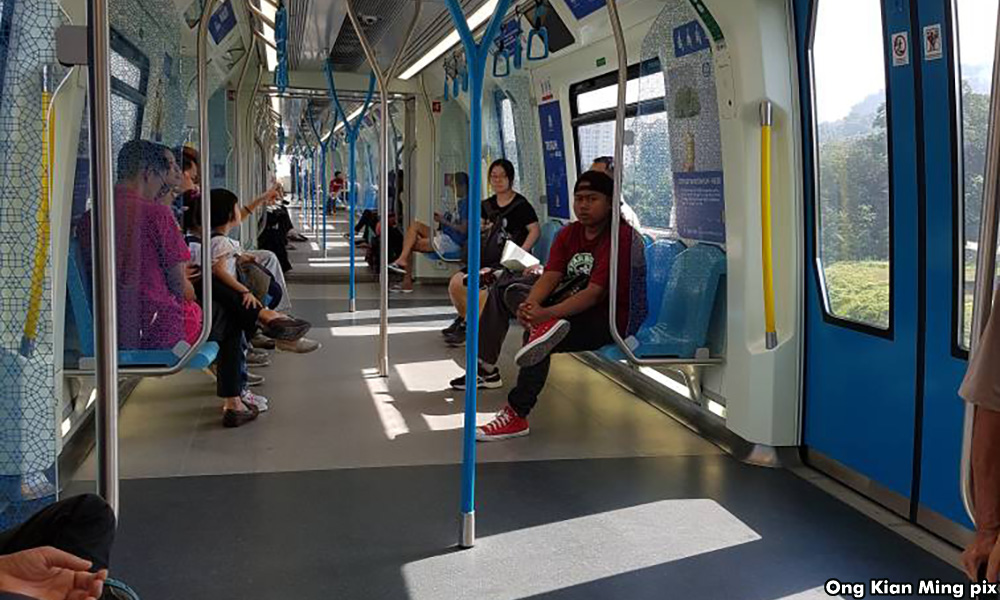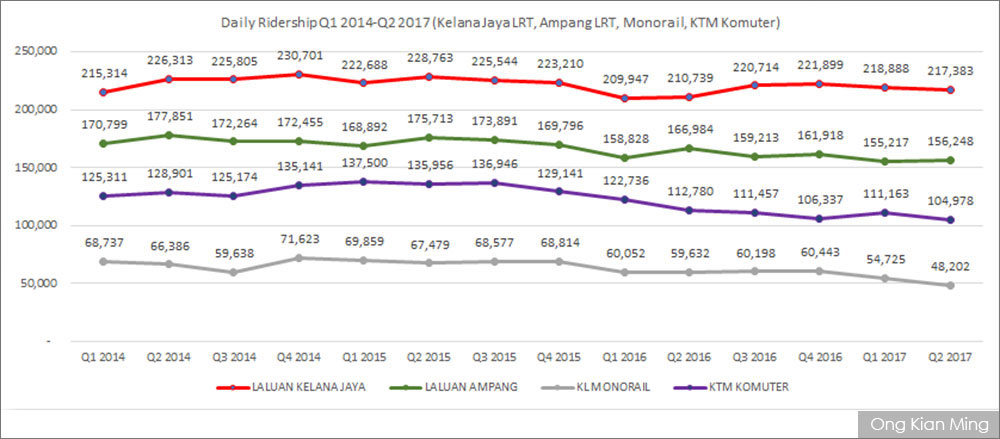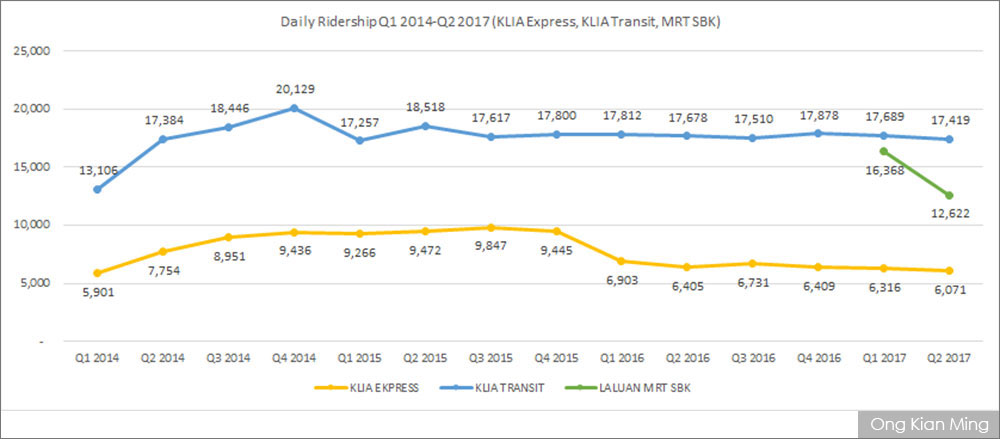
MP SPEAKS | There are some would bestow the title “Father of public transport modernisation” to Prime Minister Najib Abdul Razak because of the billions of ringgit poured into the BRT line in Sunway, the LRT extension, the new MRT line and the KTM Komuter Klang Valley Double Track (KVDT) upgrade.
But the reality is that despite the billions poured into these large public transportation rail projects, the overall ridership for the LRT, KL Monorail and KTM Komuter has not increased significantly over the past two years.
As the figures below will show, Najib’s administration should be ashamed that they have spent so much money on these projects with so little apparent benefit to the rakyat.

Figure 1 above shows the average daily ridership figures for the Kelana Jaya LRT line, the Ampang LRT line, the KL Monorail and the KTM Komuter on a quarterly basis from Q1 2014 to Q2 2017.
According to these figures, which are taken from the Transport Ministry, the daily ridership in Q2 2017 is less than the daily ridership figures for Q2 2015, just before the launch of the Sunway BRT.
For example, the daily ridership of the popular Kelana Jaya LRT was 228,763 in Q2 2015, but dropped to 217,383 in Q2 2017, despite the opening of the Sunway BRT in 2015, and the the LRT extension and Phase 1 of the Sungai Buloh-Kajang MRT line in 2016.
The RM634 million Sunway BRT was launched in June 2015. The daily ridership figures were 11,295 and 12,372 in June and July 2015 respectively, when the service was still free. The ridership figure then plunged to 4,616 in August 2015 when fares were introduced, which cost, on average, RM1 per km for a 5.4km BRT route. The high fares charged were even critiqued by the Sunway chairman, Jeffrey Cheah.
The RM8 billion LRT extension, which was launched in June 2016 (end of Q2 2016), connects the Kelana Jaya and the Ampang LRT lines. While the opening of the LRT extension seems to have boosted the daily ridership figure for the Kelana Jaya line from 210,739 in Q2 2016 to 220,714 in Q3 2016, the daily ridership figure for the Ampang line actually dropped from 166,984 in Q2 2016 to 159,213 in Q3 2016.
The opening of Phase 1 of the MRT Line 1 from Sungai Buloh to Semantan also did not increase the traffic for the KTM Komuter which connects to the MRT Line 1 in Sungai Buloh. In fact, the KTM Komuter daily ridership of 106,337 in Q3 2016 (before the opening of Phase 1 of the MRT Line 1) was higher than the daily ridership of 104,978 in Q2 2017 (approximately six months after the opening of Phase 1).
As for the KL Monorail, its daily ridership has experienced a steady decline from a high of 71,623 in Q4 2014 to a low of 48,202 in Q2 2017.

Figure 2 above shows the daily ridership of the KLIA Transit, the KLIA Ekspres and Phase 1 of the MRT-SBK Line 1 which was opened in December 2016.
For the KLIA Transit, the daily ridership of 17,419 in Q2 2017 is far lower than the 20,129 daily ridership in Q4 2014. As for the KLIA Ekspres, the daily ridership of 6,071 in Q2 2017 is also lower than the daily ridership peak of 9,847 in Q3 2015.
The daily ridership of MRT Line 1 dropped from 16,368 in Q1 2017, to 12,622 in Q2 2017, once the novelty of taking the MRT wore off and the free one-month trial period was over.
What explains the decrease in overall ridership despite the opening of the Sunway BRT, the LRT extension and the MRT Line 1?
One of the main explanations is that the cost of taking these trains is not necessarily cheaper than driving.
For example, as a letter from a reader published in a newspaper claimed, it costs him RM9 for a trip from Puchong to Sunway via the Sunway BRT, or RM18 for a return trip. Throw in the parking at the LRT station (RM4) and fuel costs, and it is estimated that it would cost him RM25 per day to take the LRT, compared to an RM10 drive (including toll costs and free parking at his office).
Daily ridership on both LRT lines, the monorail and the KTM Komuter dropped significantly from Q4 2015 to Q1 2016 because of a significant fare hike for the LRT as well as the KTM Komuter. Daily ridership figures have yet to recover from this steep fare hike despite the subsequent opening of the LRT extension in the middle of 2016.
When the Q3 2017 daily ridership figures are released later this year, I expect there to be a significant increase in the passenger numbers for the LRT and MRT because of the half-price offer during the SEA Games leading up to Merdeka, and also the opening of the full MRT Line 1 from Sungai Buloh all the way to Kajang.
But we should take these ridership figures with a pinch of salt. A more realistic gauge of daily ridership would be the Q4 2017 figures, when the half-price discounts have been taken away, and the people can more accurately estimate if it is worthwhile for them to take public rail transportation instead of using their own vehicles.
As we have seen in the examples above, ridership figures decrease significantly once the “free” or discounted periods are over.
The other reasons why the public are reluctant to use public rail transport have to do with timing and reliability. For example, it takes someone approximately 30 minutes to drive from Puchong to Sunway, but it would take about an hour for the same trip using the LRT and the BRT.
Issues of reliability continue to plague the KTM Komuter, despite the RM1.4 billion allocated for the KVDT upgrade project. Derailment and delays decreases the reliability of the KTM Komuter, which also discourages potential passengers from abandoning their cars in favour of rail transportation.
It is all fine and good when the prime minister together with his cabinet ministers and other VIPs take the BRT, the LRT and the MRT with great fanfare and publicity upon launching. But after the VIPs are gone, and after the discounted fare periods have expired, we do not see passengers voting with their feet by switching to public rail transport.
To really be a game changer, Najib must make public rail transportation affordable (for example, by introducing a monthly train and bus pass for, let’s say, RM100), reliable (avoid delays and disruptions) and accessible (solving the last mile connectivity problem).
Najib will only deserve the title of “Father of public transport modernisation” if, and only if, these issues are resolved. After all, spending money on these projects is the easy part. Getting people on the trains and buses is something else altogether.
ONG KIAN MING is Serdang MP and head of the Penang Institute in Kuala Lumpur. -Mkini



No comments:
Post a Comment
Note: Only a member of this blog may post a comment.